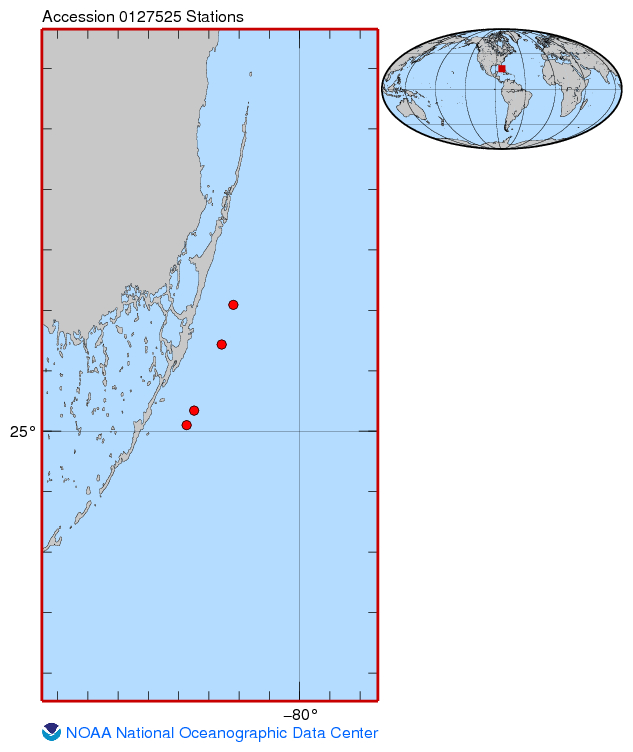Abundance and behavior of parrotfishes (Labridae, Scarinae) in the upper Florida Keys (NCEI accession 0127525)
Access & Use Information
Downloads & Resources
-
127525.1.1.tar.gz
Homepage Download of NCEI Accession 127525
-
Full Metadata Record
View the complete metadata record on InPort for more information about this...
-
Southeast Fisheries Science Center Website
About SEFSC
-
Thomas C Adam Wordpress Page
Thomas C Adam Wordpress Page
-
Ruttenberg, Benjamin I Website
Ben Ruttenberg Page
-
Home Page for NCEI Accession 0127525
Abundance and behavior of parrotfishes (Labridae, Scarinae) in the upper...
-
Mar Ecol Prog Ser 520:1-20
Journal article derived in part from this data set. Adam TC, Burkepile DE,...
-
Williams, Dana E Website
Research Gate Personal Page
-
GCMD Keyword Forum Page
Global Change Master Directory (GCMD). 2024. GCMD Keywords, Version 19....
-
NOAA Data Management Plan (DMP)PDF
NOAA Data Management Plan for this record on InPort.
Dates
| Metadata Date | May 15, 2025 |
|---|---|
| Metadata Created Date | November 12, 2020 |
| Metadata Updated Date | June 1, 2025 |
| Reference Date(s) | 2015 (publication) |
| Frequency Of Update | notPlanned |
Metadata Source
- ISO-19139 ISO-19139 Metadata
Harvested from NMFS SEFSC
Graphic Preview

Additional Metadata
| Resource Type | Dataset |
|---|---|
| Metadata Date | May 15, 2025 |
| Metadata Created Date | November 12, 2020 |
| Metadata Updated Date | June 1, 2025 |
| Reference Date(s) | 2015 (publication) |
| Responsible Party | (Custodian) |
| Contact Email | |
| Guid | gov.noaa.nmfs.inport:24177 |
| Access Constraints | Cite As: Southeast Fisheries Science Center, [Date of Access]: Abundance and behavior of parrotfishes (Labridae, Scarinae) in the upper Florida Keys (NCEI accession 0127525) [Data Date Range], https://www.fisheries.noaa.gov/inport/item/24177., Access Constraints: None, Use Constraints: Dataset credit required. Cite as: Adam, Thomas C; Kelley, Megan; Ruttenberg, Benjamin I; Burkepile, Deron E (2015). Abundance and behavior of parrotfishes (Labridae, Scarinae) in the upper Florida Keys from 2013-06-19 to 2013-07-30 (NODC Accession 0127525). National Centers for Environmental Information, NOAA. Dataset. [access date], Distribution Liability: NOAA makes no warranty regarding these data, expressed or implied, nor does the fact of distribution constitute such a warranty. NOAA and NMFS cannot assume liability for any damages caused by any errors or omissions in these data, nor as a result of the failure of these data to function on a particular system. |
| Bbox East Long | -80.21 |
| Bbox North Lat | 25.22 |
| Bbox South Lat | 25 |
| Bbox West Long | -80.38 |
| Coupled Resource | |
| Frequency Of Update | notPlanned |
| Graphic Preview Description | Sampling locations For Data Set Abundance and behavior of parrotfishes (Labridae, Scarinae) in the upper Florida Keys from 2013-06-19 to 2013-07-30 (NCEI Accession 0127525) |
| Graphic Preview File | https://www.ncei.noaa.gov/archive/accession/0127525/1.1/about/0127525_map.jpg |
| Graphic Preview Type | jpg |
| Harvest Object Id | 5a66f022-484d-41e9-9e75-b81c37e8db05 |
| Harvest Source Id | ca759a40-507d-4d0c-8f8c-64b3c5e05066 |
| Harvest Source Title | NMFS SEFSC |
| Licence | NOAA provides no warranty, nor accepts any liability occurring from any incomplete, incorrect, or misleading data, or from any incorrect, incomplete, or misleading use of the data. It is the responsibility of the user to determine whether or not the data is suitable for the intended purpose. |
| Lineage | Six individuals of each species were observed at each site for 20 min each. Foraging behavior was recorded by a SCUBA diver while towing a GPS receiver (Garmin GPS 72) attached to a surface float, which obtained position fixes of the focal fish at 15 s intervals. Fish were followed from a close distance (~ 2 m when possible), and food items were identified to the lowest taxonomic level possible, with macroalgae and coral usually identified to genus or species. |
| Metadata Language | eng |
| Metadata Type | geospatial |
| Old Spatial | {"type": "Polygon", "coordinates": [[[-80.38, 25.0], [-80.21, 25.0], [-80.21, 25.22], [-80.38, 25.22], [-80.38, 25.0]]]} |
| Progress | completed |
| Spatial Data Service Type | |
| Spatial Reference System | |
| Spatial Harvester | True |
| Temporal Extent Begin | 2013-06-19 |
| Temporal Extent End | 2013-07-30 |
Didn't find what you're looking for? Suggest a dataset here.

